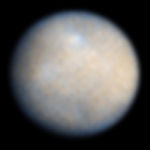- Colonization of Ceres
-
Ceres has been proposed[1][2] as one possible target for human colonization in the inner Solar System.
Contents
Physical conditions
Space colonization Ceres is a dwarf planet in the asteroid belt, comprising about one third of the mass of the whole belt and being the sixth largest body in the inner Solar System by mass and volume. It has a round planet-like shape, and a surface gravitational acceleration about 2.8% that of Earth. It has a surface area approximately 1.9% of Earth's dry land, roughly equivalent to the area of Argentina. Observations indicate that it contains large amounts of water ice,[3][4] about one-tenth of the total water in Earth's oceans. The solar irradiance of 150 W/m2 (in aphelion), which is nine times smaller than that on Earth, is still high enough for solar-power facilities.[1] The upcoming Juno mission to Jupiter, for example, will be relying on solar power in a location further out from the Sun than Ceres.
Strategic location
Being the largest body in the asteroid belt, Ceres could become the main base and transport hub for future asteroid mining infrastructure,[1] allowing mineral resources to be transported further to Mars, the Moon and Earth.
Its colonization also could become a step on the way to the colonization of the objects in the outer Solar System, such as satellites of Jupiter. Because of its small escape velocity combined with large amounts of water ice, it also could serve as a source of water, fuel and oxygen supply for ships going through and beyond the asteroid belt.[1]
The establishment of a permanent colony on Ceres might precede colonization of the Moon or Mars since the far deeper gravity wells of those bodies add dramatically to the cost and risk of colonization. As a consequence of a greater semi-major axis, Ceres has much more frequent launch windows to/from Cislunar space than to/from Mars (the synodic period is 1 year 3.3 months compared to 2 years 1.6 months), and a Hohmann transfer takes 1 year and 3.5 months.[5] It is more energy-efficient to transport resources from the Moon or Mars to Ceres, than from Earth. In fact, transportation from Mars or the Moon to Ceres is more energy-efficient than even transportation from Earth to the Moon.[6]
Potential difficulties
- Colonies and spacecraft face increased risk of collisions by asteroids.
- Ceres has no magnetic field.
- An atmosphere has not been detected on Ceres.
- Ceres receives relatively little solar radiation.
- Delta-v budget to/from cislunar space is rather higher than to Mars.
See also
References
- ^ a b c d Zachary V. Whitten. Use of Ceres in the Development of the Solar SystemPDF (16.4 KB) (Google cache)
- ^ The Ceres plan
- ^ Bjorn Carey. Largest Asteroid Might Contain More Fresh Water than Earth
- ^ Thomas, P. C.; et al. (2005). "Differentiation of the asteroid Ceres as revealed by its shape". Nature 437 (7056): 224–226. Bibcode 2005Natur.437..224T. doi:10.1038/nature03938. PMID 16148926.
- ^ Atomic Rocket: Mission Table
- ^ Robert Zubrin. The Economic Viability of Mars ColonizationPDF (146 KB)
Categories:
Wikimedia Foundation. 2010.



